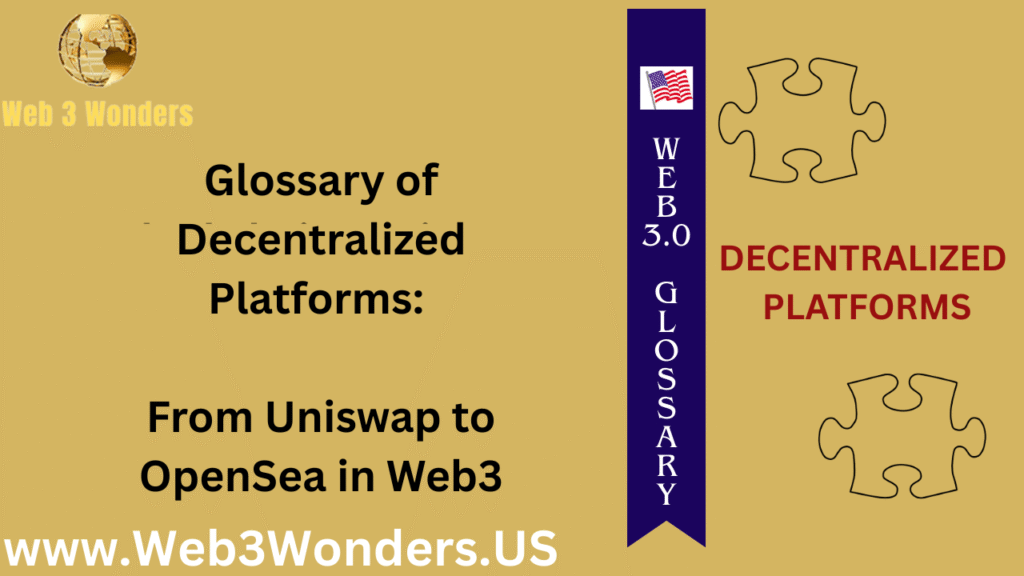Web3 is redefining the way we interact with the internet and each other, creating a world where users have more control, transparency, and freedom. At the heart of Web3 are decentralized platforms—tools and systems powered by blockchain technology that allow users to bypass traditional intermediaries. Whether you’re trading cryptocurrencies, buying NFTs, or participating in decentralized finance (DeFi), these platforms are transforming industries across the board.
In this blog, we’ll introduce you to some of the key decentralized platforms in the Web3 space, explain how they work, and provide a glossary of essential terms to help you navigate this exciting new landscape. By the end, you’ll have a solid understanding of how platforms like Uniswap and OpenSea are shaping the future. And if you’re eager to dive even deeper into the wonders of Web3, make sure to subscribe to Web3Wonders.US for more insights, guides, and updates!
What Are Decentralized Platforms?
Decentralized platforms are blockchain-based applications or systems that operate without a central authority. Unlike traditional platforms, which rely on a single organization or server, decentralized platforms use distributed networks to provide services directly to users.
Key features of decentralized platforms include:
-
- Transparency: All transactions and actions are recorded on a public blockchain.
- Security: The decentralized nature of these platforms makes them harder to hack or manipulate.
- User Control: Users retain ownership of their data, assets, and interactions.
Popular types of decentralized platforms include decentralized exchanges (DEXs), NFT marketplaces, and DeFi protocols. Let’s explore these platforms and the essential terms associated with them.
Decentralized Platforms Glossary
1. Uniswap
Uniswap is a decentralized exchange (DEX) that allows users to trade cryptocurrencies directly, without intermediaries.
How It Works: Uniswap uses an Automated Market Maker (AMM) system and liquidity pools to enable peer-to-peer trading.
Key Fact: Uniswap is built on the Ethereum blockchain and supports ERC-20 tokens.
2. OpenSea
OpenSea is a decentralized marketplace for buying, selling, and trading non-fungible tokens (NFTs).
How It Works: Users connect their wallets to OpenSea, where they can browse and trade NFTs representing art, music, virtual land, and more.
Key Fact: OpenSea is one of the largest NFT marketplaces in the world.
3. Decentralized Exchange (DEX)
A DEX is a platform that enables cryptocurrency trading without a central authority. Examples include Uniswap, SushiSwap, and PancakeSwap.
How It Works: DEXs use smart contracts to automate transactions. Users retain control of their funds in personal wallets.
Key Fact: DEXs rely on liquidity pools instead of order books for trades.
4. NFT Marketplace
An NFT marketplace is a decentralized platform where users can buy, sell, and trade non-fungible tokens. Examples include OpenSea, Rarible, and Foundation.
How It Works: Transactions are recorded on the blockchain, ensuring transparency and ownership.
Key Fact: NFT marketplaces support creators by enabling direct sales to buyers.
5. Liquidity Pool
A liquidity pool is a collection of funds locked in a smart contract, enabling DEXs to facilitate trades.
How It Works: Users deposit tokens into pools and earn rewards from transaction fees.
Key Fact: Liquidity pools make decentralized trading possible by ensuring there are assets available for exchanges.
6. Automated Market Maker (AMM)
An AMM is a system used by DEXs to automate trading and determine token prices based on supply and demand.
How It Works: Instead of matching buyers and sellers, AMMs use algorithms to calculate prices.
Key Fact: AMMs eliminate the need for traditional order books.
7. Decentralized Finance (DeFi)
DeFi refers to financial services built on blockchain technology, including lending, borrowing, and trading.
How It Works: DeFi platforms like Aave and MakerDAO use smart contracts to provide services without intermediaries.
Key Fact: DeFi platforms offer users full control over their assets.
8. Governance Token
A governance token gives users voting power in a decentralized platform’s decisions. Examples include UNI (Uniswap) and AAVE (Aave).
How It Works: Token holders vote on proposals, like changes to the platform’s rules or fees.
Key Fact: Governance tokens ensure that users have a say in platform development.
9. Wallet Integration
Wallet integration allows users to connect their digital wallets to decentralized platforms for transactions. Popular wallets include MetaMask and Trust Wallet.
Key Fact: Wallets give users full control of their funds and private keys.
10. Gas Fees
Gas fees are payments made to compensate blockchain validators for processing transactions.
How It Works: Fees vary based on network activity and transaction complexity.
Key Fact: High gas fees are common on Ethereum during busy periods, but Layer 2 solutions help reduce costs.
11. Cross-Chain Compatibility
Cross-chain compatibility refers to the ability of decentralized platforms to interact with multiple blockchain networks.
Key Fact: Projects like Polkadot and Cosmos enable cross-chain compatibility, expanding platform ecosystems.
Why Decentralized Platforms Matter
Decentralized platforms are reshaping industries by offering new ways to trade, invest, and interact. Here’s why they’re important:
-
- Empowerment: Users control their assets and data without relying on third parties.
- Accessibility: Decentralized platforms are open to anyone with an internet connection.
- Innovation: Platforms like Uniswap and OpenSea are introducing new models for finance, art, and commerce.
Whether you’re a trader, artist, or developer, decentralized platforms provide opportunities to explore and grow in the Web3 ecosystem.
How to Get Started with Decentralized Platforms
Choose a Wallet: Set up a digital wallet like MetaMask to store your assets and interact with platforms.
-
- Explore DEXs: Use platforms like Uniswap to trade cryptocurrencies directly.
- Discover NFTs: Browse marketplaces like OpenSea to explore and trade digital assets.
- Participate in Governance: Use governance tokens to vote on platform decisions.
Remember, always DYOR (Do Your Own Research) before using any platform to ensure its legitimacy and safety.
Call to Action
Want to learn more about the exciting world of Web3 and decentralized platforms? Subscribe to Web3Wonders.US today!
At Web3Wonders.US, we simplify complex Web3 topics and provide you with the tools and knowledge to explore blockchain confidently.
Join us for:
Comprehensive glossaries and beginner-friendly guides.
Insights into decentralized platforms, protocols, and applications.
Updates on the latest innovations in Web3.
Step into the future of decentralization—subscribe now and discover the wonders of Web3 with us!
Disclaimer: NOT Financial Advise
Listen up, Web3 warriors! Diving into digital asset investing – whether it’s snagging some ADA, riding the Link oracle wave or chasing ETH dreams – is like exploring a cosmic jungle of centralized possibilities. But hold your spacesuits! This info is NOT financial advice. WE’re just biting in the Web3 universe, sharing knowledge for your intergalactic journey not steering your rocket ship.
Web3 is all about empowerment – taking the helm of your data, identify and finance like a true sovereign caption, It’s you, your wallet and your private keys (because, you know not your keys, not your coins! ), With great power comes great responsibility, so do your own research (DYOR), channel your inner detective, and navigate the blockchain frontier with caution and curiosity Price can moon or crater, scams lurk like space pirates and lockup periods might test your patience, Consult a financial advisor before blasting off, and only invest what you’re ready to stake in this wild, decentralized universe.
Embrace the Web3 ethos, own your sovereignty. No financial advisors were harmed in the making of this disclaimer.

